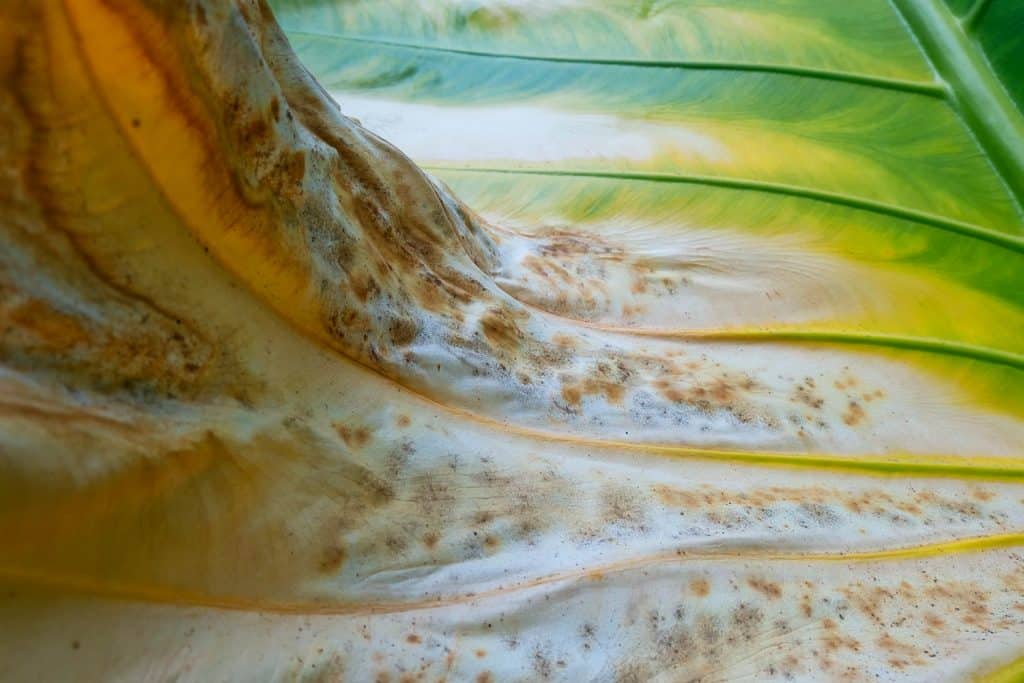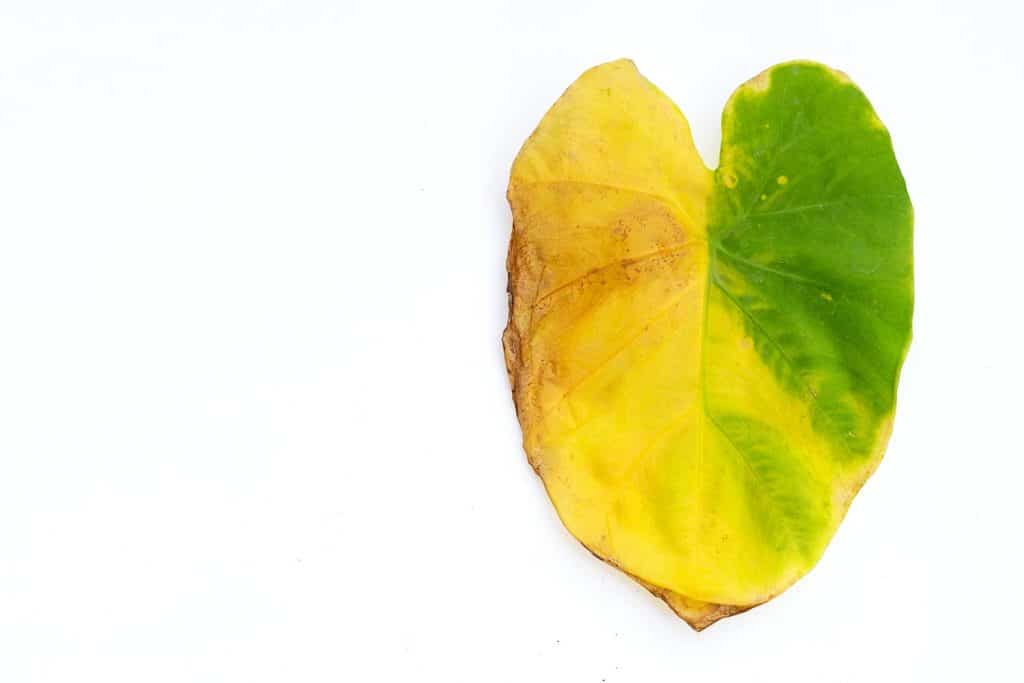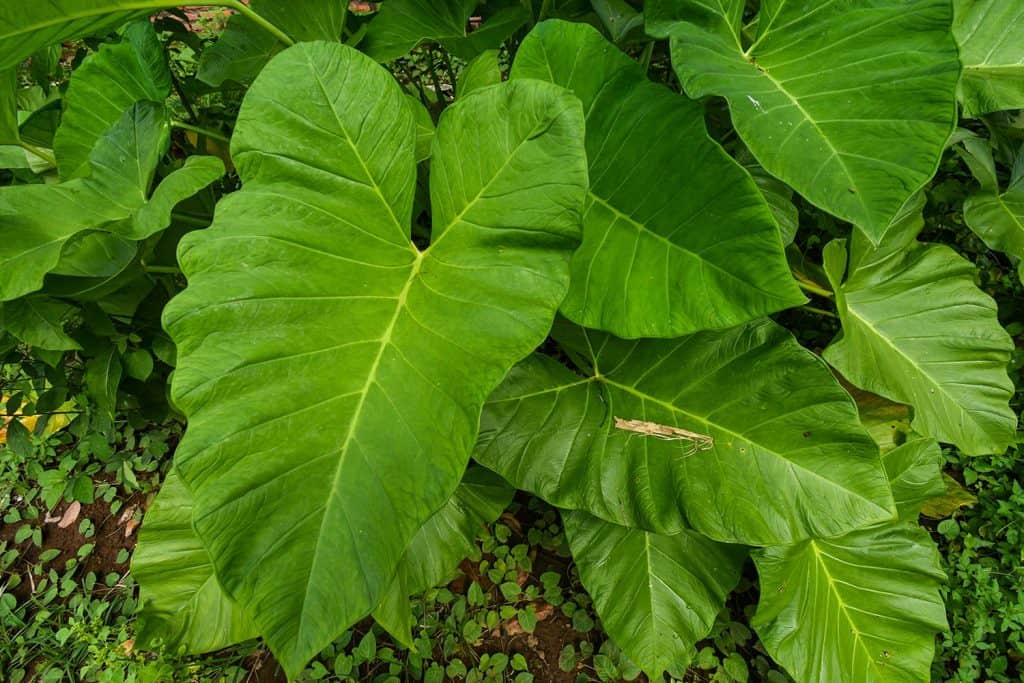Elephant ear plants can add depth, dimension, and general beauty to any landscape. But like any plant, they can sometimes start to die out of what seems like nowhere. There's always a reason that your elephant ear plant is dying. We've done the research to help you figure out what that reason is and what to do about it.
The main causes of elephant ear plants dying include:
- Growing in the wrong climate
- Not enough or too much water
- Too much sun
- Lack of nutrients
- Not enough space
After reading the reasons above, you may already have an idea of what might be wrong with your plant. But if you still aren't sure, don't worry. We're here to help you identify a cause and come up with a solution so you can bring your elephant ear back to life. Continue reading to learn more.
![An elephant ear plant on the pot, Why Is My Elephant Ear Plant Dying? [And What To Do About It]](https://gardentabs.com/wp-content/uploads/2021/10/Why-Is-My-Elephant-Ear-Plant-Dying-.-683x1024.png)
Contents
Why Is My Elephant Ear Plant Dying?

Follow this list of potential causes to help you diagnose the cause of your elephant ear dying. For each cause, we'll also provide solutions for how to fix it.
Growing In The Wrong Climate
There are several different varieties of elephant ear plants, but they all have one thing in common. They prefer tropical or subtropical climates that are warm and receive a lot of humidity.
When it comes to the survival of plants, hardiness zones are designated based on climate and given a number 1-11. These zones are labeled on the plants as well so that you can make sure you're buying a plant that will thrive in your particular zone.
Elephant ears have the greatest chance of survival in zones 8 through 11. In zones 8 and 9, they will likely die back in the winter but start to grow back during the next growing season. In zones 10 and 11, they will probably stay green all year. But in zones 1-7, they will likely die during winter (or even before it gets too cold) and may not return the following year.
Solution
The first step is to identify which hardiness zone you live in. If you live in zone 10 or 11 and your elephant ear starts to die, this is likely caused by another problem other than being in the wrong climate.
If you live in zone 7, 8, or 9 and your elephant ear starts to die as it gets cold, don't worry. This is normal, and your plant should come back next year. But if your plant starts to die and winter is nowhere near, there is likely another cause of the problem.
If you live in zones 1 through 6, you likely experience colder temperatures earlier in the year and longer than in other zones. Your elephant ear probably won't survive outside for an extended time. Instead, you can plant it in a pot and move it inside when it gets cold or keep it inside permanently.
Not Enough Or Too Much Water
Tropical climates receive a lot of rainfall, so elephant ears prefer soil that is consistently moist. But, it is also possible to drown them by providing too much water. Not getting enough or getting too much water can both cause your plant to die.
Solution
Stick a plant moisture meter or your finger into the soil to check the amount of moisture in the soil. The soil should feel damp. If it is soggy, you are overwatering the plant. If it feels dry, you aren't watering it enough.
For too wet soil, let it dry out for a few days before you water your elephant ear again. Wet soil can drown the plant; it can also promote mold and fungus growth which can also kill it.
If the soil is too dry, water it promptly and recheck the soil the next day. Water it again if necessary. Sticking to a watering schedule, especially during periods of drought, can help you make sure your plant is getting the right amount of water.
Too Much Sun
Tropical plants such as elephant ears typically grow in the understory of the forest. That means many large trees above them to help filter the sunlight that the plant receives.
Elephant ears don't grow well in locations where they receive full sun. They need to be planted in locations where they receive partial or indirect sunlight. If the leaves are turning brown and seem dried out, but the soil's moisture level is fine, then too much sun is likely the cause.
Solution
This is a really easy fix. All you need to do is dig up the elephant ear and move it to a new, less sunny location. Just make sure to keep the tuber intact when you dig it up. Otherwise, your plant may not survive in its new location either.
Lack Of Nutrients
If the leaves on your elephant ear plant are looking less green or even starting to turn yellow, it's likely that they aren't receiving enough nutrients. Usually, this problem occurs in elephant ears that are planted in pots. But it can happen when planted in the ground, especially if the soil is poor.
Solution
The most effective solution to this problem is to fertilize your plant. An all-purpose fertilizer should provide the nutrients that your elephant ear needs, but you need to apply it regularly. For elephant ears that stay indoors or in pots, you'll need to fertilize them every two to three weeks. Outdoor elephant ears can be fertilized once every four to six weeks.
Not Enough Space
The last reason that your elephant ear may be dying is that it doesn't have enough space. Plants will die if they don't have room to grow. And if you plant elephant ears too close to other plants, it may have to compete for nutrients. If you grow elephant ears in pots or planters, the container may be too small as well.
Solution
Elephant ears should be planted four feet apart from other elephant ears or plants. You may need to dig up your elephant ear or the plants around it and move them to a different location. For elephant ears in containers, try planting them in a larger container to see if that solves the problem.
See More: Why Is My Azalea Dying?
Should You Cut Off Dead Elephant Ear Leaves?
If your elephant ear plant has dead leaves on it, but the rest of the plant is still alive, it is a good idea to cut off the dead leaves. That way, your plant can devote its energy to growing new leaves and using nutrients for the still alive leaves.
If you live in one of the hardiness zones where your elephant ears die back each year (7, 8, and 9), all of the leaves will turn brown when the frost starts to hit. In that case, you can cut off all the dead leaves. You should begin to see new growth when temperatures start to warm up again in spring or summer.
Why Do Elephant Ear Leaves Turn Yellow?

There are four reasons why elephant ear plants turn yellow:
- Not enough water
- Not enough sunlight
- The pot is too small
- The plant is going dormant
If the reason for the leaves on your elephant ear plant turning yellow is due to numbers 1, 2, or 3, you can remedy this by following one of the solutions above. But if none of those reasons seem to be the problem, number 4 is likely the cause.
If your plant goes dormant, it is totally normal. They usually go dormant during the winter. They aren't dying, they just stop growing, and there is nothing you can do to prevent it. You just have to wait until it warms up and your plant starts to grow again.
See More: Snake Plant Leaves Turn Yellow - What To Do?
Do Elephant Ear Plants Grow Back?
As long as they are dormant and not dead, elephant ear plants should grow back as long as they are grown in the correct hardiness zone (7-11). If the plant dies due to one of the problems above, it won't come back, and you will have to replace it.
How Often Should You Water Elephant Ears?

There is no definite timeline for how often you should water elephant ears. The general rule is to water them when the top two inches of soil feels dry. In the hot summer months, they may require more frequent watering as the soil dries out faster.
Even when your plant is dormant during the winter, it still needs to be watered. However, you may not have to water it as often because the soil won't dry out as quickly.
In Closing
There are many reasons why your elephant ear plant could be dying. The most likely causes are that they aren't receiving the right amount of water or sunlight. But a lack of nutrients or space or growing them in the wrong climate could also be the problem. If you can diagnose the problem quickly, you should be able to save your plant. Thanks for reading!
